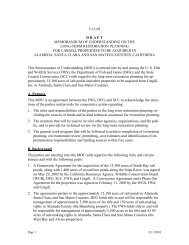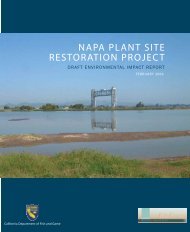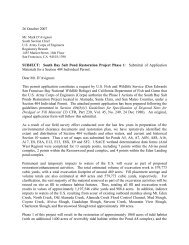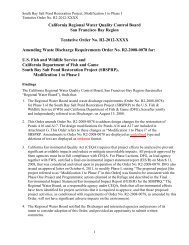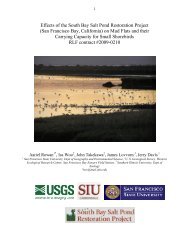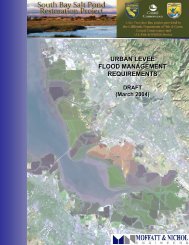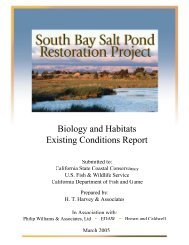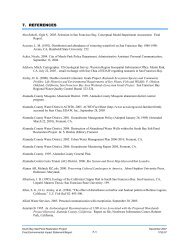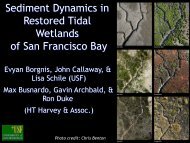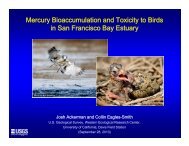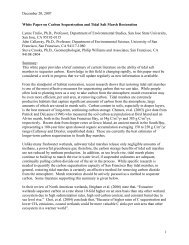M E M O R A N D U M - South Bay Salt Pond Restoration Project
M E M O R A N D U M - South Bay Salt Pond Restoration Project
M E M O R A N D U M - South Bay Salt Pond Restoration Project
Create successful ePaper yourself
Turn your PDF publications into a flip-book with our unique Google optimized e-Paper software.
elevations that are not conducive to the use of gravity flow (i.e., ponds that are deeply subsided and thus<br />
can not be easily drained or ponds that are elevated well above mean tide level and thus can not be easily<br />
flooded), or to manage water levels in extremely wet or dry years.<br />
Whether all, or just a subset, of these pond types will ultimately be incorporated into restoration planning<br />
will depend on the outcome of further design refinements. The benefit to cost trade-off of the various<br />
managed pond habitat types will be assessed during evaluation of the preliminary program alternatives in<br />
the spring of 2005 and the mix of managed pond types may be revised for the final program alternatives<br />
prior to NEPA/CEQA assessment.<br />
The use of recycled fresh water for flooding (i.e., to assist in the management of water levels) in at least<br />
some ponds was initially considered. However, control of tall, dense emergent vegetation such as cattails<br />
and bulrush (e.g., to maintain suitable shorebird foraging and habitat) would be more difficult in<br />
freshwater ponds than in higher-salinity ponds, and salt marsh vegetation that might be used by salt marsh<br />
harvest mice in vegetated ponds would not be supported by fresh water. Therefore, the use of recycled<br />
fresh water to maintain water levels in ponds would not address the project objectives as well as the use<br />
of bay water, and this option was not recommended for further consideration.<br />
4.1.1.1 Enhanced <strong>Pond</strong>s<br />
Enhanced ponds will not undergo extensive grading or reconfiguration, but will be improved (relative to<br />
their ISP condition) by management of water levels specifically for the purpose of providing suitable<br />
habitat for targeted species, and potentially by the limited creation of islands in some ponds. Creation of<br />
islands will provide habitat for nesting, roosting, and foraging birds. Water management regimes will be<br />
enhanced to provide improved mudflat and open-water foraging habitat for certain suites of species, to<br />
manage/limit vegetation, and/or to create nesting habitat for species such as the Snowy Plover via altered<br />
flooding and drying regimes. It is expected that the densities of targeted bird species (e.g., shorebirds in<br />
shallower ponds or portions of ponds, and waterfowl and piscivores in deeper ponds or areas) can be<br />
increased above current levels through enhanced water level management.<br />
Enhanced water level management will occur through operational changes (in response to lessons learned<br />
through the adaptive management process) and installation of additional water control structures as<br />
needed. Water levels would be monitored regularly and managed as needed via gravity-flow control<br />
structures, with pumping used only if necessary. Muted tidal exchange may be used in some situations to<br />
maintain appropriate habitat conditions. Salinity will be close to that of bay water in most enhanced<br />
ponds, providing suitable conditions for a variety of fish and benthic invertebrates, but may be elevated to<br />
some extent in “intermediate” ponds that transfer water between intake ponds and high-salinity ponds.<br />
Existing levees and water control structures will be maintained, and vegetation management (i.e., removal<br />
and/or inhibition of growth) on islands may be required.<br />
<strong>South</strong> <strong>Bay</strong> <strong>Salt</strong> <strong>Pond</strong> <strong>Restoration</strong> <strong>Project</strong> January 2005<br />
Preliminary <strong>Project</strong> Alternatives Memorandum 5 1750.01





